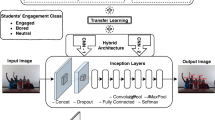Abstract
This research aims for investigation of workers in an industrial environment and can be used as an alternate for monitoring an attention of operator in real-time. Detection of attentiveness and non-attentiveness of people working in an industry could help to identify the weaknesses and strengths of any industrial organization. Human factor is the main and the most critical part of any industrial organization. As a special case, we have established how to detect student attention in the classroom using deep learning techniques along with computer vision. Convolutional Neural Network (CNN) and Long Short-Term Memory (LSTM) are used to extract the percentage of attentiveness and non-attentiveness of students based on the student emotions in the classroom. We used the FER-2013 data set for this paper. As per the study, human has finite number of emotions. So, it is easy if we include some emotions in an attentive (Happy, Anger, Surprised and Neutral) domain and some emotions in non-attentive (Sad, Fear and Disgust) domain. This will help the teacher in a way that he can easily evaluate his class attentiveness. On another side, it is also the evaluation of the teacher’s teaching methodology because if the students are engaged in his lecture it means his teaching methodology is good and if most of the students are not engaged then the teacher needs to revise his methodology of teaching in order to engage his class during the lecture.
Access this chapter
Tax calculation will be finalised at checkout
Purchases are for personal use only
Similar content being viewed by others
References
Park, S.: Student engagement and classroom variables in improving mathematics achievement. Asia Pacific Educ. Rev. 6, 87–97 (2005). https://doi.org/10.1007/BF03024970
Kraushaar, J.M., Novak, D.C.: Examining the affects of student multitasking with laptops during the lecture. J. Inf. Syst. Educ. 21(2) (2019). Article 11
Nicole: Kaggle, 02 April 2019. https://www.kaggle.com/nicolejyt/facialexpressionrecognition
Krithika, L.B., Lakshmi Priya, G.G.: Student emotion recognition system (SERS) for e-learning improvement based on learner concentration metric. Procedia Comput. Sci. 85(Cms), 767–776 (2016)
Martin, J., Torres, A.: User’s Guide and Toolkit for the Surveys of Student Engagement: The High School Survey of Student Engagement (HSSSE) and the Middle Grades Survey of Student Engagement (MGSSE) I. What is Student Engagement and Why is it Important? (2016). http://www.isbe.net/learningsupports/pdfs/engagement-concept.pdf. Accessed 04 Oct 2019
Skinner, E.A., Pitzer, J.R.: Developmental dynamics of student engagement, coping, and everyday resilience. In: Christenson, S., Reschly, A., Wylie, C. (eds.) Handbook of Research on Student Engagement, pp. 21–44. Springer, Boston (2012). https://doi.org/10.1007/978-1-4614-2018-7_2
Hobsons.com: How to Increase Student Engagement at your School A Guide to Connecting Learning and Life Through Three Dimensions of Student Engagement 2 About Hobsons (2013)
Zaletelj, J., Košir, A.: Predicting students’ attention in the classroom from Kinect facial and body features. Eurasip. J. Image Video Process. 2017(1), 80 (2017)
Veliyath, N., De, P., Allen, A.A., Hodges, C.B., Mitra, A.: Modeling students’ attention in the classroom using eyetrackers. In: ACMSE 2019 – Proceedings of the 2019 ACM Southeast Conference, pp. 2–9 (2019)
Salman, A., et al.: Real-time fish detection in complex backgrounds using probabilistic background modelling. Ecol. Inform. 51, 44–51 (2019)
Afzal, M.Z., et al.: Document image binarization using LSTM: a sequence learning approach. In: Proceedings of the 3rd International Workshop on Historical Document Imaging and Processing (2015)
Siddiqui, S.A., et al.: Automatic fish species classification in underwater videos: exploiting pre-trained deep neural network models to compensate for limited labelled data. ICES J. Mar. Sci. 75(1), 374–389 (2018)
Uzair, M., et al.: Representation learning with deep extreme learning machines for efficient image set classification. Neural Comput. Appl. 30(4), 1211–1223 (2018)
Van den Oord, A., Dieleman, S., Schrauwen, B.: Deep content-based music recommendation. In: Advances in Neural Information Processing Systems (2013)
Collobert, R., Weston, J.: A unified architecture for natural language processing: deep neural networks with multitask learning. In: Proceedings of the 25th International Conference on Machine Learning (2008)
Huang, Y., Wang, W., Wang, L.: Instance-aware image and sentence matching with selective multimodal LSTM. In: Proceedings of the IEEE Conference on Computer Vision and Pattern Recognition (2017)
Sak, H., Senior, A., Beaufays, F.: Long short-term memory recurrent neural network architectures for large scale acoustic modeling. In: Proceedings of the Annual Conference of the International Speech Communication Association, INTERSPEECH, pp. 338–342 (2014)
Graves, A., Liwicki, M., Fernández, S., Bertolami, R., Bunke, H., Schmidhuber, J.: A novel connectionist system for unconstrained handwriting recognition. IEEE Trans. Pattern Anal. Mach. Intell. 31(5), 855–868 (2009). https://doi.org/10.1109/TPAMI.2008.137
Acknowledgement
We would like to acknowledge School of Electrical Engineering and Computer Sciences (SEECS), National University of Sciences and Technology (NUST), Islamabad, for technical support and funding.
Author information
Authors and Affiliations
Corresponding author
Editor information
Editors and Affiliations
Rights and permissions
Copyright information
© 2021 The Editor(s) (if applicable) and The Author(s), under exclusive license to Springer Nature Switzerland AG
About this paper
Cite this paper
Gerard, N. et al. (2021). Detection of Subject Attention in an Active Environment Through Facial Expressions Using Deep Learning Techniques and Computer Vision. In: Ayaz, H., Asgher, U. (eds) Advances in Neuroergonomics and Cognitive Engineering. AHFE 2020. Advances in Intelligent Systems and Computing, vol 1201. Springer, Cham. https://doi.org/10.1007/978-3-030-51041-1_43
Download citation
DOI: https://doi.org/10.1007/978-3-030-51041-1_43
Published:
Publisher Name: Springer, Cham
Print ISBN: 978-3-030-51040-4
Online ISBN: 978-3-030-51041-1
eBook Packages: Intelligent Technologies and RoboticsIntelligent Technologies and Robotics (R0)




